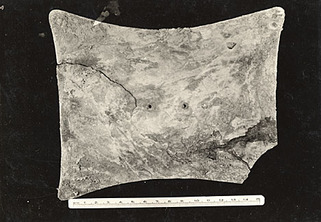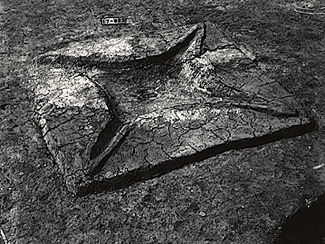Okay, that's a bit of an overstatement. He didn't use them all, just more than his fair share. The occasion was his announcement that he has proved that "Minoans discovered America 4000 years BEFORE Columbus!" (emphasis in original). Pulitzer's liberal use of all caps and exclamation points, apparently to indicate the importance of his claims and communicate his significant enthusiasm for them, has left the rest of us a little short. This post will be necessarily conservative in its use of those two precious commodities.
You should look at Pulitzer's post and decide if you think the monopolization of the supply of capital letters and exclamation points was justified.
As you might guess, I'm not impressed.
My first reaction as I skimmed through Pulitzer's post about his "audit archives research" on May 24th was "wtf?" (normally that would be in caps, but there's a shortage on you know). He posts some pictures of some oxhide ingots from the Uluburun shipwreck (as his "comparative" sample) and then 16 photos of features and artifacts from archaeological sites in Tennessee and Kentucky, all now labeled "Minoan" by Pulitzer. The photos appear to have come from the WPA Archaeological Photo Archives of the McClung Museum of Natural History and Culture at the University of Tennessee. Obviously, whoever decided to post all these photographs online really dropped the ball on keeping all this "forbidden history" hidden from the public. Maybe there was a memo missed somewhere.
Too late now: the cat's out of the bag. (I really feel like that statement would have popped more with some exclamation points, but somebody hogged them all. At least there's still italics.)
 Copper artifact from Drake Mound, KY.
Copper artifact from Drake Mound, KY. The artifact from Drake Mound, as well as several of the other artifacts shown by Pulitzer, do have the same basic shape as some of the European oxhide ingots: roughly rectangular with four concave sides. But are they same size? Do they weigh the same? Are they made from pounded copper or are they cast? And why do some of them have pairs of holes drilled in them? Do any European oxhides have holes drilled in them?
Those are questions that someone who was actually doing research would attempt to address. If it were me, I would start with size: how big are the copper reels that Pulitzer says are actually cast oxhide ingots, and how do those dimensions compare with those documented for European oxhide ingots? For a moment I thought about doing that comparison myself, but then I decided I've got better things to do with my time and the person making the claim should do some work. I'll help out by pointing him to this source: Copper Oxhide Ingot Marks: A Database and Comparative Analysis. It's an M.A. Thesis by Alaina M. Kaiser from 2013. There are metric data in Appendix IV. You're welcome.
What about dates from any of the features or structures that are claimed to be Minoan? Any information on those?
 Feature from the Charles Lea Farm site, TN.
Feature from the Charles Lea Farm site, TN. Writing "Minoan" on a WPA photograph does not actually mean that one has proven that the remains are Minoan. It only means that one has photo editing software, which is all that is required to make an assertion. If I were to write "idiot" on a photograph of a person, for example, I have only asserted that the person is an idiot: I would still have to demonstrate idiocy in order to prove my claim. I think I would do that by paying more attention to the question marks (you'll notice there are still plenty of those to go around) than to the exclamation points. With all the melodrama and hullabaloo surrounding the fantastic assertions of Pulitzer about "forbidden history" and his "smoking gun archaeological evidence," you would think there would be more indications of effort.
At the end of the piece, Pulitzer is quoted as saying “If there ever was a better open and shut archaeological case this discovery is it!” I'm not sure what the case is supposed to "better" than, but I can list a lot of things it's worse than. I wish I had a spare exclamation point to put there.
First, on the initial reaction to the piece. As soon as this was posted, I was told by some fans of "forbidden history" that I should be focusing on the substance of Pulitzer's "theory" rather than simply attacking his style. If you read the piece carefully, you'll find that my major point is that there IS NO SUBSTANCE to attack (Hey look - the drought in capital letters has eased up! And so has the shortage of exclamation points!!). You'll see I never actually said Pulitzer's "theory" is wrong: I said I wasn't impressed with what he presents. He didn't even do the simplest things he could have done to actually make a case based on evidence, basically relying almost completely on assertions (bolstered by lots of exclamation points and capital letters - those seemed to comprise the main forms of support). I pointed out a couple of things that would be easy steps to take if one wanted to present a case that the Tennessee and Kentucky materials were actually made by Minoans. The photo of the alleged "Minoan Ox Hide Ingot" from the Drake Mound in Kentucky has a scale with it, for example, and measurements of that artifact could be compared with are metric data available for ox hides from Europe. Why not do a comparison? As I said in the piece, I thought about doing it myself, but it's really not my job: it's the job of the person making the claim. You want to claim something from Kentucky is an "exact match" to something from Europe? Prove it! My point is that he doesn't even try to prove it, he just proclaims it. The piece was about the silliness of making assertions without putting even a minimum amount of effort into trying to back them up. Pushing the "!" key is easy, doing the other stuff is a bit harder.
Second, interested archaeologists and others with more knowledge than me about these kinds of copper artifacts have started pointing out publications that are available online that contain useful information. I thought I would provide links to those here so that anyone who's interested can go and see for themselves:
- Powell, J. W. 1894. Twelfth Annual Report of the Bureau of Ethnology to the Secretary of the Smithsonian Institution. Washington, D. C.: Government Printing Office. [pp. 426-427 illustrate a hammered copper gorget that is the shape of an "ox hide" but measures only 3.5 x 3.75 inches and is 1/8 inch thick].
- Trevalyn, Amelia M. 2004. Miskwabik, Metal of Ritual: Metallurgy in Precontact Eastern North America. Lexington: University Press of Kentucky.


 RSS Feed
RSS Feed
